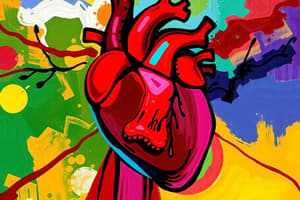Podcast
Questions and Answers
Rank the events sequentially to empty the ventricles.
Rank the events sequentially to empty the ventricles.
Intraventricular pressure begins to increase. = 1 Atrioventricular (AV) valves close. = 2 Isovolumetric contraction occurs. = 3 Intraventricular pressure rises above arterial pressure. = 4 Semilunar valves open. = 5 Ventricular ejection occurs. = 6
The root word ______ means 'vessel.'
The root word ______ means 'vessel.'
vas-
The root word ______ means 'pressure.'
The root word ______ means 'pressure.'
-tension
The root word ______ means 'heart.'
The root word ______ means 'heart.'
The root word ______ means 'hard.'
The root word ______ means 'hard.'
The root word ______ means 'liver.'
The root word ______ means 'liver.'
An infection of the liver is called ______.
An infection of the liver is called ______.
A surgeon who repairs damaged blood vessels is called a ______ surgeon.
A surgeon who repairs damaged blood vessels is called a ______ surgeon.
The membrane surrounding the heart is the ______.
The membrane surrounding the heart is the ______.
______ is a condition in which arteries harden.
______ is a condition in which arteries harden.
______ is lower than normal blood pressure.
______ is lower than normal blood pressure.
______: The first wave on an ECG that follows the firing of the SA node.
______: The first wave on an ECG that follows the firing of the SA node.
______: The large wave that results from the depolarization of the ventricles.
______: The large wave that results from the depolarization of the ventricles.
______: The third wave that results from currents flowing during the repolarization of the ventricles.
______: The third wave that results from currents flowing during the repolarization of the ventricles.
During ______, the ventricles fill with blood.
During ______, the ventricles fill with blood.
During ______, the ventricles contract.
During ______, the ventricles contract.
During ______, the ventricles relax.
During ______, the ventricles relax.
What is happening during mid-to-late diastole? (Choose all that apply)
What is happening during mid-to-late diastole? (Choose all that apply)
Which of the following statements best summarizes the early diastolic phase after ventricular contraction?
Which of the following statements best summarizes the early diastolic phase after ventricular contraction?
Events of the cardiac cycle in order.
Events of the cardiac cycle in order.
______: the friction red blood cells encounter when moving past each other.
______: the friction red blood cells encounter when moving past each other.
______: the volume of blood pumped out by one ventricle each minute.
______: the volume of blood pumped out by one ventricle each minute.
______: the force of the blood against the vessel wall.
______: the force of the blood against the vessel wall.
______: the amount of friction blood encounters during flow through blood vessels.
______: the amount of friction blood encounters during flow through blood vessels.
Blood pressure would INCREASE as a result of a DECREASE in __________.
Blood pressure would INCREASE as a result of a DECREASE in __________.
Flashcards are hidden until you start studying
Study Notes
Cardiovascular System Concepts
- Ventricular systole: High pressure in the ventricles pushes blood into arteries; atria are in diastole.
- Sequence of events during ventricular emptying:
- Intraventricular pressure begins to rise.
- Atrioventricular (AV) valves close.
- Isovolumetric contraction occurs.
- Intraventricular pressure exceeds arterial pressure.
- Semilunar valves open.
- Blood is ejected from the ventricles.
Root Words and Their Meanings
- vas-: Means "vessel."
- -tension: Means "pressure."
- cardi-: Means "heart."
- scler-: Means "hard."
- hepat-: Means "liver."
Medical Conditions and Procedures
- Hepatitis: Infection of the liver.
- Vascular surgeon: Specialist who repairs damaged blood vessels.
- Pericardium: Membrane protecting the heart.
- Arteriosclerosis: Condition where arteries become hardened.
- Hypotension: Lower than normal blood pressure.
Cardiac Events and Waves
- P wave: Represents atrial depolarization; first wave on ECG after SA node firing.
- QRS complex: Indicates ventricular depolarization; precedes ventricular contraction.
- T wave: Reflects repolarization of the ventricles.
Phases of the Cardiac Cycle
- Mid-to-late diastole: Atria contract, AV valves are open, blood fills ventricles from veins, aiding preparation for systole.
- Systole: Ventricles contract, pushing blood into arteries.
- Early diastole: Ventricles relax after contraction.
Summary of Cardiac Cycle Events
- Blood passively flows through atria and AV valves.
- Pressure in receiving chambers increases; blood exits through AV valves.
- All valves close; ventricular pressure rises.
- High ventricular pressure forces blood through semilunar valves.
- Ventricular pressure decreases once valves are closed.
Blood Properties
- Blood viscosity: Friction red blood cells face moving past each other.
- Cardiac output: Volume of blood pumped by one ventricle each minute.
- Blood pressure: Force of blood against vessel walls.
- Total peripheral resistance: Friction blood encounters during vessel flow.
Factors Affecting Blood Pressure
- Blood pressure increases with a decrease in blood vessel diameter.
Studying That Suits You
Use AI to generate personalized quizzes and flashcards to suit your learning preferences.




